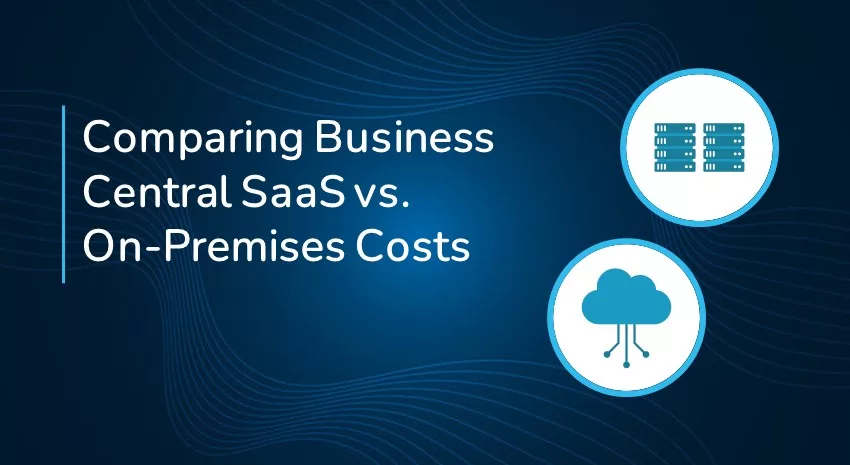SaaS or On-Premises? Factors that Affect Your Business Central Deployment Options

When discussing deployment options, many clients want to know if they should run Business Central (BC) on-premises or move to the cloud (Software as a Service or SaaS).
For most deployments, particularly for small, growing companies, the SaaS option makes sense: It does not require a significant outlay of cash for capital expenditures for equipment and software, it avoids the need for IT staff with specialized hardware knowledge, it comes with enterprise-grade security, and it provides failover and backup capabilities, among other benefits.
For most businesses, SaaS is an ideal solution. SaaS also makes perfect sense if you are starting out and don’t have the staff or backup infrastructure, or are outsourcing your IT team.
However, there are times when on-premises makes sense as well.
Choosing on-premises over SaaS: When you currently have (and will continue to have) the infrastructure in place
If you already have the infrastructure and will continue to need it going forward, then choosing an on-premises deployment might be more reasonable.
Companies that fall into this category are typically medium to large companies that have already purchased the required software, servers, and network equipment and invested in building out the computer environment to support them (i.e., full server room with cooling, server-safe fire suppression and electrical faults, plans and procedures to mitigate downtime/loss/ransomware risks, etc.). These companies typically are not just running their ERP on-premises, but they also run other critical business software on these servers as well. They have trained staff to support the applications, backup and restore capabilities, and security controls to ensure continuous operation. In this situation, the company has already paid for the computer equipment, and it will continue to pay for the maintenance and support to support the hardware and software, regardless of whether or not Business Central is on-premises or in the cloud.
If you have already invested in on-premises equipment and will keep it regardless of where Business Central is deployed, then a case can be made to keep BC on-premises.
Choosing on-premises over SaaS: When you don’t require the features available only on cloud deployments
Business Central has certain features that are limited or unavailable in on-premises deployments. For example, BC’s Excel add-in requires Azure Active Directory to authenticate the user. As another example, sandbox environments cannot connect to on-premises deployments. Microsoft has published a list of features not available for on-premises deployments of Business Central.
Deploying BC in the cloud is unnecessary if you don’t require the features only available for BC SaaS.
Choosing on-premises over SaaS: When you expect to exceed the operational limits of BC SaaS
Operational limits are imposed on BC SaaS to ensure it operates correctly in the cloud. While these limits are not likely to impact most companies, such as a maximum number of 300 companies in one environment, you should review the impact on your expected use of Business Central before committing to on-premises or cloud deployment.
For example, each cloud instance of Business Central comes with 80 GB of database storage plus additional storage for each user based on the license type across all environments.
| License type | Additional database storage for each license |
| Premium | 3 GB |
| Essential | 2 GB |
| Device | 1 GB |
So, if a company has 10 premium user licenses, they will have 30 additional GB of storage for a total of 110 GB of database storage. Users can purchase additional database capacity and environments if they require more storage space.
You can learn more about managing storage capacity for Business Central SaaS here.
Other examples of operational limitations of BC SaaS include:
- Maximum file size of 350 MB for files to upload or download
- A maximum of 1,000,00 rows processed in a report
- Plus, limits on the maximum number of OData requests and concurrent SOAP requests
Microsoft has a complete list of the operational limits of Business Central SaaS here.
Other factors that can influence the cost of cloud deployments include your growth rate, number and size of transactions, and number of users.
All SaaS-based ERPs have operational limits, not just Business Central. However, BC is one of the few ERPs that is equally at home on-premises or in the cloud.
It’s a good idea for any company evaluating the two deployment options to at least review the list of operational limits and ensure none of them will impact their business or know how to plan accordingly, like having multiple tenants.
SaaS or on-prem? It depends.
Every business is different, and many factors must be considered to determine the optimal deployment options for Business Central.
Contact ArcherPoint if you have questions about which deployment option you should choose. We can help you decide the best choice for your unique situation and how to optimize Business Central for your company.
